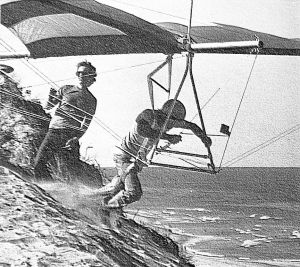Home (contents) → Chronology → Hang gliding 1974 part 4 → Scientific American hang glider
Scientific American hang glider
It is an astonishing sensation to run along the ground for a few steps and rise effortlessly into the air.
— Michael A. Markowski quoted by C.L. Strong, Scientific American, December 1974
The images on this page are artistic derivations of contemporary photos. See Copyright of early hang gliding photos.

Mike Markowski’s Eagle III was an attempt at achieving the performance of contemporary rigid wings such as the Icarus V combined with the portability of a Rogallo.

Author’s reminiscence: After a bleak day’s flying primitive standard Rogallo hang gliders in February 1975 at Melbury hill, near Shaftsbury in Dorset, England, I sat in a car with other hang glider pilots. Darkness fell while we waited for others to finish de-rigging, and the December 1974 edition of Scientific American was passed around. On the cover was a Ted Lodigensky painting of Mike Markowski’s Eagle III, the ‘Princeton sailwing.’ Inside, pages of aerodynamic explanation, photos, and diagrams were to be read and ‘inwardly digested’ by all young men not wanting to be left behind.
Technical
The Eagle III used a double surface sail wrapped around a large diameter leading edge tube and a cable running inside the trailing edge. The cable provided chord-wise tension, with enough flexibility in the airframe for it to curve. The primary characteristic of the concept, developed at Princeton University after World War 2, is that its camber and, therefore, lift coefficient, changes with angle of attack. That contrasts with a rigid wing or a modern flex-wing with camber defined by chord-wise battens.

Control of the Eagle III was of conventional airplane type, consisting of rudder, elevators, and ailerons. The latter were a bit different in that they were inside the fabric of the wings, thus acting both as ailerons and wing warping. Markowski called them warperons.
Although configured with a harness and control frame much like a weight shift controlled Rogallo wing hang glider, lateral weight shift cannot have played much part in roll control, if any. Notice in the launch photo that the elevator wires are attached to the control stick directly, the top wire of the pair routing close under the pilot’s right arm. That leaves little scope for lateral weight shift to the right, particularly when it was flown with a prone harness. As for pitch, I would guess that every little helped, weight shift included, for the following reasons.

This photo shows a shorter keel than later photos in Wings Unlimited. It seems to me that Markowski lengthened the distance between the wing trailing edge and the tail assembly, likely to give the elevators more leverage over the aerodynamic center of the sail shifting longitudinally, giving a delayed ‘positive feedback’ pitching moment, which you do not, repeat not, want. (Been there, done that, got the t-shirt…) Every photo of the Eagle III in flight that I have seen shows the stick either fully forward or fully back!
Hang glider designers nowadays go to some lengths to prevent camber from changing at differing angles of attack. More pertinent to the positive feedback pitch problem (in my view) a more rigid airfoil shape prevents the aerodynamic center from shifting fore and aft when airspeed changes.
Designer
After obtaining a degree in aerospace engineering at Pennsylvania State University in 1968, Mike Markowski worked on wind tunnels for the Douglas aircraft company in California, Sikorsky helicopters, and NASA before taking up the new activity of hang gliding in 1971. In 1972, the 25-year-old Markowski was rigging his first hang glider on a hill in Framingham, Massachusetts, when the 16-year old Tom Peghiny approached, offering to help. The two subsequently co-founded the east coast manufacturer Sky Sports. (See Flying squad for a history of that manufacturer.) Markowski went on to start his own hang glider manufacturing enterprise, Man Flight Systems.

I am reliably informed that Peghiny also flew the Eagle III. He reportedly flew the CLARK (Cylindrical Low Aspect Ratio Kite) which bears some hallmarks of Markowski’s Rogallo hang glider manufacture.
Markowski later shifted emphasis to writing and publishing books on light aviation, especially the phenomenon of powered ultralights, which emerged from hang gliding in the late 1970s.
Related
Cylindrical Rogallo in Rogallo wing definitions and diagrams for another development to which Markowski is said to have contributed
Douglas Aircraft: Coincidentally, Tom Price worked for the Douglas Aircraft company for a time, although I do not knew whether he and Mike met. See Tom Price’s flying machines.
Flex-wings with tails related topics menu
Developments 1978-9 in Hang gliding 1978 and 1979 part 2 for Tom Peghiny’s Eagle monoplane style hang glider with a V-tail
Tom Peghiny related topics menu
External links
Been there, done that, got the t-shirt: Experimental in Three-sixty degree appraisal (hang gliding 1976) on Brave guys and beautiful dolls
Michael A. Markowski page of video interviews on the Harrisburg living legacy web site
Painting the Eagle III on Brave Guys and Beautiful Dolls
Sources
About Us page of Aeronautical Publishers web site (October 2020)
I am reliably informed…: Reply by Jonathan Dietch in a related topic on the British Hangies Facebook group
Scientific American, December 1974
Wings Unlimited, April-May 1975